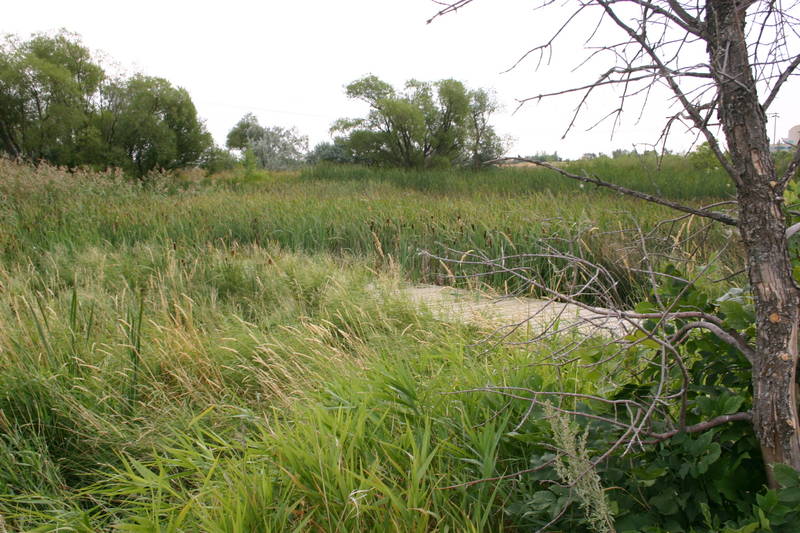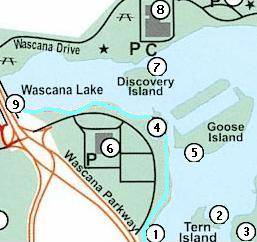
1.35 kilometers - 20 minutes
 A growing awareness of the natural environment and a realization of its fragility has resulted in an increased emphasis on the preservation of plant and animal life.
A growing awareness of the natural environment and a realization of its fragility has resulted in an increased emphasis on the preservation of plant and animal life.
The foresight of urban planners in 1913 initially provided Regina with a Game Preserve. In 1961, one year prior to the formation of Wascana Centre, ideas for the Waterfowl Park started to take form. At this time, the Regina Waterfowl Park Committee presented a brief to the Wascana Centre Planning Committee which offered three objectives:
a) The establishment and enlargement in population of birds and other wildlife.
b) The development, preservation and maintenance of a natural marsh condition in the area with the associated native flora.
c) The encouragement of area to be used by the public, organized groups, and the University for research, education and special recreation purposes.
This walk covers a section of the Wascana Waterfowl Park and provides the opportunity to see the balance between a completely natural, undisturbed preserve and a habitat designed for public education and enjoyment. To have included such a natural area within the city limits is unique and unprecedented in North America. Its maintenance shows a dedication to the environment and a realization of the finite aspects of nature if left unprotected.
- This walk begins along the boardwalk by the shoreline at 23rd Avenue and Broad Street. Constructed in 1979, its purpose is to protect the shoreline from erosion.
Although the lake area between Albert and Broad Street was deepened in 1930, this particular area was left undisturbed. The shallow marshes, slow moving waters and lush and varied vegetation are the ingredients for a natural prairie marsh and an appropriate location for our waterfowl park.
- A little further along and through the trees is Tern Island, a small man-made island. This island was the annual nesting ground for about 25 pairs of terns, however as the island matured, the trees discouraged the nesting of large numbers of terns. This small whitish-grey bird with a black patch on top of its head can be seen hovering over the water ready to dive for minnows. American Avocet have found Tern Island a safe place to nest – watch for Avocets flying overhead and feeding on shorelines.
- Across the water to the east is Wascana Hill. It is approximately 18 meters high and is used for recreational purposes such as tobogganing, cross-country skiing and mountain biking. The hill was constructed using soil from various building excavation sites in Wascana Centre and Regina.
- Continuing along the path is a fenced in area known as the Waterfowl Display Ponds. During the summer, visitors are welcome to walk around the display ponds to see a variety of waterfowl. With the aid of display panels, the birds can be studied at leisure.
- The Islands located behind the Display Ponds are known as Goose Island. The islands are an ideal location for Canada Geese to nest as it is close to water and is undisturbed by humans. Every year approximately 250 nests can be found on the Islands.
- The large building to the west is the Saskatchewan Centre of the Arts, built as a centennial project in 1967 for the Province of Saskatchewan and renamed the Conexus Arts Centre in 2006. It provides southern Saskatchewan with a versatile centre for cultural and theatrical productions. The cream colored Manitoba Tyndall stone accented by the dark brown Estevan Brick add interest to the exterior of the building. The Saskatchewan Centre the Arts was completed in 1970.
- Pelican Island is a new island that was created with soil that was excavated during the lake deepening in 2004. The island is a good location to spot pelicans, terns, gulls, and many other waterfowl.
- Across the water to the north is the Saskatchewan Science Centre and the Kramer Imax Theatre. The Science Centre has fun and educational exhibits for all ages to enjoy; the Imax Theatre shows the most technically advanced motion pictures in the world.
To the left is a metal structure entitled "The Four Seasons". This piece of abstract art was created by Doug Bentham and purchased by Wascana Centre Authority in 1981 for $17,000 to advance cultural arts.
- To the west is the Broad Street Bridge which forms the western boundary of Waterfowl Park. Waterfowl Park extends beyond the Trans-Canada bypass and covers a total area of 222.3 hectares. Sailing and rowing is not allowed east of the Broad Street Bridge, therefore the waterfowl and other wildlife need never fear their marsh will be disturbed by humans.
Wascana Centre, with the advice of the Park Ecologist and the Friends of Wascana Marsh, will continue its dedication to the protection of Waterfowl Park and the preservation of its natural habitat.
We are proud to be one of the few cities in the world fortunate enough to have a waterfowl park within the city limits.



with our newsletter